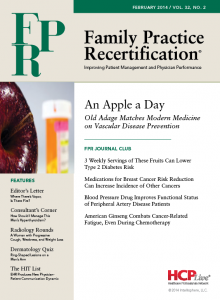Publication
Article
Family Practice Recertification
Old Adage Matches Modern Medicine on Vascular Disease Prevention
Author(s):
A proverb assessment modeling study compares the theoretical influence of a statin a day versus an apple a day on the primary prevention of vascular disease.
Frank J. Domino, MD
Review
Briggs ADM, Mizdrak A, Scarborough P. A statin a day keeps the doctor away: comparative proverb assessment modeling study. BMJ. 2013;347:f7267. http://www.bmj.com/content/347/bmj.f7267.
Study Methods
This proverb assessment modeling study was conducted to compare the theoretical influence of a statin a day versus an apple a day on the primary prevention of vascular disease.
Data on vascular mortality was collected from the Cholesterol Treatment Trialists’ meta-analysis, which found a typical statin dose reduces the relative risk of cerebrovascular disease, ischemic heart disease (IHD), heart failure (HF), and abdominal aortic aneurysm (AAA) by 12% per 1 mmol/L reduction in low-density lipoprotein (LDL) cholesterol, equivalent to taking a 20 mg simvastatin tablet (95% confidence interval [CI], 9-16%).
Assuming a 70% compliance rate, the modeling study authors then applied that annual reduction to sex- and age-specific vascular mortality rates among adults in the United Kingdom who were aged over 50 years and were not taking a statin for primary disease prevention. The authors then analyzed data on the effect of an apple a day among the entire UK population aged 50 years and older, regardless of statin intake. They based the influence of consuming an apple a day on the Preventable Risk Integrated Model (PRIME), which relies on meta-analyses to predict the relationships among a wide range of nutritional factors and chronic disease mortality.
Using the PRIME risk assessment tool, the authors assumed a new apple a day intake; thus, they did not include data on baseline apple consumption that was used in the supporting meta-analyses. They assumed an apple compliance rate of 70% and an unchanged rate of statin prescribing.
Results and Outcomes
The authors estimated 17.6 million UK patients over age 50 met the criteria to be offered an intervention for the primary prevention of vascular disease. Using the 70% compliance rate, they projected recommending statin treatment to an extra 17.6 million adults would result in a reduction in the annual number of vascular deaths by 9,400. Applying the 70% compliance rate to the apple a day intervention, they estimated the annual number of averted or delayed vascular deaths to be 8,500 (95% CI, 6,200-10,800).
In terms of adverse events, prescribing statins for primary disease prevention to all UK patients over age 50 was predicted to cause 120 excess myopathy cases, 200 rhabdomyolysis cases, and 12,300 statin-induced diabetes cases. On the contrary, no adverse outcomes were suggested for apple consumption.
The total additional cost of statin treatment from the drug alone was estimated at $295 million, compared to $423 million for the apples.
Conclusion
Vascular mortality may be reduced by both nutritional and pharmaceutical approaches. Although the apples’ estimated price tag was greater than the cost of the drug, an apple a day was much less costly when side effects, hospitalizations, lab testing, and drug-induced morbidity and mortality were considered.
Commentary
Although it is somewhat controversial, statin use for the primary prevention of vascular disease is commonplace in the Western world. While there is a significant collection of data evaluating the benefit of statin use, there is no equally robust dataset demonstrating the benefit of eating an apple a day, likely because no vested interest has taken on the challenge.
Nevertheless, this study found the use of an apple a day was just as effective as a drug intervention, even with the authors’ assumed 70% compliance rate. Even more startling was the risk of adverse events with medication use, whereas no side effects were seen with apple intake.
However, there are many weaknesses associated with modeling studies. Though estimates must be made with regard to patient compliance, patient self-reporting of side effects, ease of treatment administration, and unforeseen and unrecorded complications, even 1 case of rhabdomyolysis and potential renal failure is alarming, and more than 12,000 new cases of statin-induced diabetes is sobering. Making an assumption about the accuracy of an apple’s benefit compared to its unlikely risk of adverse events should encourage family physicians to accept some of this study’s weaknesses and respect the small yet real risks of statin use for primary prevention.
Despite this data, it remains unlikely that a national health system will adopt the "apple a day" idiom, given the infrastructure and influence of related industries will continue to support pharmaceutical interventions. Nonetheless, all providers should take note of the probable equivalent efficacy of adding one simple food per day, even if that efficacy is roughly estimated.
All family physicians should endorse the apple a day recommendation and perhaps suggest concurrent apple consumption among those taking a statin for the primary prevention of vascular disease. While the latter proposition lacks supportive clinical evidence, its risks are extremely small compared to its expected benefit.
Let’s hope the apple industry funds a robust randomized control trial to test the recommendation, while disease prevention organizations consider the relative value of statins for the primary prevention of vascular disease compared to other measures like dietary change and exercise.
About the Author
Frank J. Domino, MD, is Professor and Pre-Doctoral Education Director for the Department of Family Medicine and Community Health at the University of Massachusetts Medical School in Worcester, MA. Domino is Editor-in-Chief of the 5-Minute Clinical Consult series (Lippincott Williams & Wilkins). Additionally, he is Co-Author and Editor of the Epocrates LAB database, and author and editor to the MedPearls smartphone app. He presents nationally for the American Academy of Family Medicine and serves as the Family Physician Representative to the Harvard Medical School’s Continuing Education Committee.




